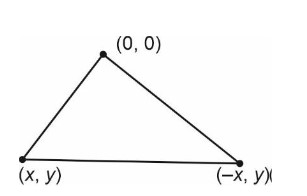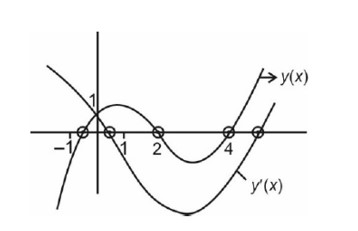Correct Option - 1
Detailed Solution: TSA of cube
=
6
a
2
d
d
t
6
a
2
=
4.8
;
12
a
d
a
d
t
=
4.8
;
a
d
a
d
t
=
0.4
;
d
v
d
t
=
d
d
t
a
3
⇒
3
a
a
d
a
d
t
3
×
15
×
0.4
=
3
×
15
×
04
10
⇒
18
<p>TSA of cube <span contenteditable="false"> <math> <mo>=</mo> <mn>6</mn> <msup> <mrow> <mrow> <mi>a</mi> </mrow> </mrow> <mrow> <mrow> <mn>2</mn> </mrow> </mrow> </msup> </math> </span><!-- [if gte msEquation 12]><m:oMath><span style='font-family:"Cambria Math",serif'><m:r><m:rPr><m:scr m:val="roman"/><m:sty m:val="p"/></m:rPr>=6</m:r></span><m:sSup><m:sSupPr><span style='font-family: "Cambria Math",serif;mso-ascii-font-family:"Cambria Math";mso-hansi-font-family: "Cambria Math"'><m:ctrlPr></m:ctrlPr></span></m:sSupPr><m:e><i style='mso-bidi-font-style:normal'><span style='font-family:"Cambria Math",serif'><m:r>a</m:r></span></i></m:e><m:sup><span style='font-family:"Cambria Math",serif'><m:r><m:rPr><m:scr m:val="roman"/><m:sty m:val="p"/></m:rPr>2</m:r></span></m:sup></m:sSup></m:oMath><![endif]--><!-- [if !msEquation]--> <!--[endif]--></p><p><span contenteditable="false"> <math> <mfrac> <mrow> <mrow> <mi>d</mi> </mrow> </mrow> <mrow> <mrow> <mi>d</mi> <mi>t</mi> </mrow> </mrow> </mfrac> <mfenced separators="|"> <mrow> <mrow> <mn>6</mn> <msup> <mrow> <mrow> <mi>a</mi> </mrow> </mrow> <mrow> <mrow> <mn>2</mn> </mrow> </mrow> </msup> </mrow> </mrow> </mfenced> <mo>=</mo> <mn>4.8</mn> <mo>;</mo> <mn>12</mn> <mi>a</mi> <mfrac> <mrow> <mrow> <mi>d</mi> <mi>a</mi> </mrow> </mrow> <mrow> <mrow> <mi>d</mi> <mi>t</mi> </mrow> </mrow> </mfrac> <mo>=</mo> <mn>4.8</mn> <mo>;</mo> <mi>a</mi> <mfrac> <mrow> <mrow> <mi>d</mi> <mi>a</mi> </mrow> </mrow> <mrow> <mrow> <mi>d</mi> <mi>t</mi> </mrow> </mrow> </mfrac> <mo>=</mo> <mn>0.4</mn> <mo>;</mo> <mfrac> <mrow> <mrow> <mi>d</mi> <mi>v</mi> </mrow> </mrow> <mrow> <mrow> <mi>d</mi> <mi>t</mi> </mrow> </mrow> </mfrac> <mo>=</mo> <mfrac> <mrow> <mrow> <mi>d</mi> </mrow> </mrow> <mrow> <mrow> <mi>d</mi> <mi>t</mi> </mrow> </mrow> </mfrac> <mfenced separators="|"> <mrow> <mrow> <msup> <mrow> <mrow> <mi>a</mi> </mrow> </mrow> <mrow> <mrow> <mn>3</mn> </mrow> </mrow> </msup> </mrow> </mrow> </mfenced> <mo>⇒</mo> <mn>3</mn> <mi>a</mi> <mfenced separators="|"> <mrow> <mrow> <mi>a</mi> <mfrac> <mrow> <mrow> <mi>d</mi> <mi>a</mi> </mrow> </mrow> <mrow> <mrow> <mi>d</mi> <mi>t</mi> </mrow> </mrow> </mfrac> </mrow> </mrow> </mfenced> </math> </span></p><p><span contenteditable="false"> <math> <mn>3</mn> <mo>×</mo> <mn>15</mn> <mo>×</mo> <mn>0.4</mn> <mo>=</mo> <mn>3</mn> <mo>×</mo> <mn>15</mn> <mo>×</mo> <mfrac> <mrow> <mrow> <mn>04</mn> </mrow> </mrow> <mrow> <mrow> <mn>10</mn> </mrow> </mrow> </mfrac> <mo>⇒</mo> <mn>18</mn> </math> </span></p><p><!-- [if gte msEquation 12]><m:oMathPara><m:oMathParaPr><m:jc m:val="left"/></m:oMathParaPr><m:oMath><m:f><m:fPr><span style='font-family: "Cambria Math",serif;mso-ascii-font-family:"Cambria Math";mso-hansi-font-family: "Cambria Math"'><m:ctrlPr></m:ctrlPr></span></m:fPr><m:num><i style='mso-bidi-font-style:normal'><span style='font-family:"Cambria Math",serif'><m:r>d</m:r></span></i></m:num><m:den><i style='mso-bidi-font-style:normal'><span style='font-family:"Cambria Math",serif'><m:r>dt</m:r></span></i></m:den></m:f><m:d><m:dPr><span style='font-family:"Cambria Math",serif;mso-ascii-font-family:"Cambria Math"; mso-hansi-font-family:"Cambria Math"'><m:ctrlPr></m:ctrlPr></span></m:dPr><m:e><span style='font-family:"Cambria Math",serif'><m:r><m:rPr><m:scr m:val="roman"/><m:sty m:val="p"/></m:rPr>6</m:r></span><m:sSup><m:sSupPr><span style='font-family:"Cambria Math",serif;mso-ascii-font-family:"Cambria Math"; mso-hansi-font-family:"Cambria Math"'><m:ctrlPr></m:ctrlPr></span></m:sSupPr><m:e><i style='mso-bidi-font-style:normal'><span style='font-family:"Cambria Math",serif'><m:r>a</m:r></span></i></m:e><m:sup><span style='font-family:"Cambria Math",serif'><m:r><m:rPr><m:scr m:val="roman"/><m:sty m:val="p"/></m:rPr>2</m:r></span></m:sup></m:sSup></m:e></m:d><span style='font-family:"Cambria Math",serif'><m:r><m:rPr><m:scr m:val="roman"/><m:sty m:val="p"/></m:rPr>=4.8;12</m:r><m:r><i style='mso-bidi-font-style:normal'>a</i></m:r></span><m:f><m:fPr><span style='font-family:"Cambria Math",serif;mso-ascii-font-family:"Cambria Math"; mso-hansi-font-family:"Cambria Math"'><m:ctrlPr></m:ctrlPr></span></m:fPr><m:num><i style='mso-bidi-font-style:normal'><span style='font-family:"Cambria Math",serif'><m:r>da</m:r></span></i></m:num><m:den><i style='mso-bidi-font-style:normal'><span style='font-family:"Cambria Math",serif'><m:r>dt</m:r></span></i></m:den></m:f><span style='font-family:"Cambria Math",serif'><m:r><m:rPr><m:scr m:val="roman"/><m:sty m:val="p"/></m:rPr>=4.8;</m:r><m:r><i style='mso-bidi-font-style:normal'>a</i></m:r></span><m:f><m:fPr><span style='font-family:"Cambria Math",serif;mso-ascii-font-family:"Cambria Math"; mso-hansi-font-family:"Cambria Math"'><m:ctrlPr></m:ctrlPr></span></m:fPr><m:num><i style='mso-bidi-font-style:normal'><span style='font-family:"Cambria Math",serif'><m:r>da</m:r></span></i></m:num><m:den><i style='mso-bidi-font-style:normal'><span style='font-family:"Cambria Math",serif'><m:r>dt</m:r></span></i></m:den></m:f><span style='font-family:"Cambria Math",serif'><m:r><m:rPr><m:scr m:val="roman"/><m:sty m:val="p"/></m:rPr>=0.4;</m:r></span><m:f><m:fPr><span style='font-family: "Cambria Math",serif;mso-ascii-font-family:"Cambria Math";mso-hansi-font-family: "Cambria Math"'><m:ctrlPr></m:ctrlPr></span></m:fPr><m:num><i style='mso-bidi-font-style:normal'><span style='font-family:"Cambria Math",serif'><m:r>dv</m:r></span></i></m:num><m:den><i style='mso-bidi-font-style:normal'><span style='font-family:"Cambria Math",serif'><m:r>dt</m:r></span></i></m:den></m:f><span style='font-family:"Cambria Math",serif'><m:r><m:rPr><m:scr m:val="roman"/><m:sty m:val="p"/></m:rPr>=</m:r></span><m:f><m:fPr><span style='font-family: "Cambria Math",serif;mso-ascii-font-family:"Cambria Math";mso-hansi-font-family: "Cambria Math"'><m:ctrlPr></m:ctrlPr></span></m:fPr><m:num><i style='mso-bidi-font-style:normal'><span style='font-family:"Cambria Math",serif'><m:r>d</m:r></span></i></m:num><m:den><i style='mso-bidi-font-style:normal'><span style='font-family:"Cambria Math",serif'><m:r>dt</m:r></span></i></m:den></m:f><m:d><m:dPr><span style='font-family:"Cambria Math",serif;mso-ascii-font-family:"Cambria Math"; mso-hansi-font-family:"Cambria Math"'><m:ctrlPr></m:ctrlPr></span></m:dPr><m:e><m:sSup><m:sSupPr><span style='font-family:"Cambria Math",serif;mso-ascii-font-family:"Cambria Math"; mso-hansi-font-family:"Cambria Math"'><m:ctrlPr></m:ctrlPr></span></m:sSupPr><m:e><i style='mso-bidi-font-style:normal'><span style='font-family:"Cambria Math",serif'><m:r>a</m:r></span></i></m:e><m:sup><span style='font-family:"Cambria Math",serif'><m:r><m:rPr><m:scr m:val="roman"/><m:sty m:val="p"/></m:rPr>3</m:r></span></m:sup></m:sSup></m:e></m:d><span style='font-family:"Cambria Math",serif'><m:r><m:rPr><m:scr m:val="roman"/><m:sty m:val="p"/></m:rPr>⇒3</m:r><m:r><i style='mso-bidi-font-style:normal'>a</i></m:r></span><m:d><m:dPr><span style='font-family:"Cambria Math",serif;mso-ascii-font-family:"Cambria Math"; mso-hansi-font-family:"Cambria Math"'><m:ctrlPr></m:ctrlPr></span></m:dPr><m:e><i style='mso-bidi-font-style:normal'><span style='font-family:"Cambria Math",serif'><m:r>a</m:r></span></i><m:f><m:fPr><span style='font-family:"Cambria Math",serif;mso-ascii-font-family:"Cambria Math"; mso-hansi-font-family:"Cambria Math"'><m:ctrlPr></m:ctrlPr></span></m:fPr><m:num><i style='mso-bidi-font-style:normal'><span style='font-family:"Cambria Math",serif'><m:r>da</m:r></span></i></m:num><m:den><i style='mso-bidi-font-style:normal'><span style='font-family:"Cambria Math",serif'><m:r>dt</m:r></span></i></m:den></m:f></m:e></m:d></m:oMath></m:oMathPara><![endif]--><!-- [if !msEquation]--> <!--[endif]--></p><p><!-- [if gte msEquation 12]><m:oMathPara><m:oMathParaPr><m:jc m:val="left"/></m:oMathParaPr><m:oMath><span style='font-family:"Cambria Math",serif'><m:r><m:rPr><m:scr m:val="roman"/><m:sty m:val="p"/></m:rPr>3×15×0.4=3×15×</m:r></span><m:f><m:fPr><span style='font-family:"Cambria Math",serif;mso-ascii-font-family:"Cambria Math"; mso-hansi-font-family:"Cambria Math"'><m:ctrlPr></m:ctrlPr></span></m:fPr><m:num><span style='font-family:"Cambria Math",serif'><m:r><m:rPr><m:scr m:val="roman"/><m:sty m:val="p"/></m:rPr>04</m:r></span></m:num><m:den><span style='font-family: "Cambria Math",serif'><m:r><m:rPr><m:scr m:val="roman"/><m:sty m:val="p"/></m:rPr>10</m:r></span></m:den></m:f><span style='font-family:"Cambria Math",serif'><m:r><m:rPr><m:scr m:val="roman"/><m:sty m:val="p"/></m:rPr>⇒18</m:r></span></m:oMath></m:oMathPara><![endif]--><!-- [if !msEquation]--> <!--[endif]--></p><p><!-- [if gte msEquation 12]><m:oMathPara><m:oMathParaPr><m:jc m:val="left"/></m:oMathParaPr><m:oMath><m:f><m:fPr><span style='font-family: "Cambria Math",serif;mso-ascii-font-family:"Cambria Math";mso-hansi-font-family: "Cambria Math"'><m:ctrlPr></m:ctrlPr></span></m:fPr><m:num><i style='mso-bidi-font-style:normal'><span style='font-family:"Cambria Math",serif'><m:r>d</m:r></span></i></m:num><m:den><i style='mso-bidi-font-style:normal'><span style='font-family:"Cambria Math",serif'><m:r>dt</m:r></span></i></m:den></m:f><m:d><m:dPr><span style='font-family:"Cambria Math",serif;mso-ascii-font-family:"Cambria Math"; mso-hansi-font-family:"Cambria Math"'><m:ctrlPr></m:ctrlPr></span></m:dPr><m:e><span style='font-family:"Cambria Math",serif'><m:r><m:rPr><m:scr m:val="roman"/><m:sty m:val="p"/></m:rPr>6</m:r></span><m:sSup><m:sSupPr><span style='font-family:"Cambria Math",serif;mso-ascii-font-family:"Cambria Math"; mso-hansi-font-family:"Cambria Math"'><m:ctrlPr></m:ctrlPr></span></m:sSupPr><m:e><i style='mso-bidi-font-style:normal'><span style='font-family:"Cambria Math",serif'><m:r>a</m:r></span></i></m:e><m:sup><span style='font-family:"Cambria Math",serif'><m:r><m:rPr><m:scr m:val="roman"/><m:sty m:val="p"/></m:rPr>2</m:r></span></m:sup></m:sSup></m:e></m:d><span style='font-family:"Cambria Math",serif'><m:r><m:rPr><m:scr m:val="roman"/><m:sty m:val="p"/></m:rPr>=4.8;12</m:r><m:r><i style='mso-bidi-font-style:normal'>a</i></m:r></span><m:f><m:fPr><span style='font-family:"Cambria Math",serif;mso-ascii-font-family:"Cambria Math"; mso-hansi-font-family:"Cambria Math"'><m:ctrlPr></m:ctrlPr></span></m:fPr><m:num><i style='mso-bidi-font-style:normal'><span style='font-family:"Cambria Math",serif'><m:r>da</m:r></span></i></m:num><m:den><i style='mso-bidi-font-style:normal'><span style='font-family:"Cambria Math",serif'><m:r>dt</m:r></span></i></m:den></m:f><span style='font-family:"Cambria Math",serif'><m:r><m:rPr><m:scr m:val="roman"/><m:sty m:val="p"/></m:rPr>=4.8;</m:r><m:r><i style='mso-bidi-font-style:normal'>a</i></m:r></span><m:f><m:fPr><span style='font-family:"Cambria Math",serif;mso-ascii-font-family:"Cambria Math"; mso-hansi-font-family:"Cambria Math"'><m:ctrlPr></m:ctrlPr></span></m:fPr><m:num><i style='mso-bidi-font-style:normal'><span style='font-family:"Cambria Math",serif'><m:r>da</m:r></span></i></m:num><m:den><i style='mso-bidi-font-style:normal'><span style='font-family:"Cambria Math",serif'><m:r>dt</m:r></span></i></m:den></m:f><span style='font-family:"Cambria Math",serif'><m:r><m:rPr><m:scr m:val="roman"/><m:sty m:val="p"/></m:rPr>=0.4;</m:r></span><m:f><m:fPr><span style='font-family: "Cambria Math",serif;mso-ascii-font-family:"Cambria Math";mso-hansi-font-family: "Cambria Math"'><m:ctrlPr></m:ctrlPr></span></m:fPr><m:num><i style='mso-bidi-font-style:normal'><span style='font-family:"Cambria Math",serif'><m:r>dv</m:r></span></i></m:num><m:den><i style='mso-bidi-font-style:normal'><span style='font-family:"Cambria Math",serif'><m:r>dt</m:r></span></i></m:den></m:f><span style='font-family:"Cambria Math",serif'><m:r><m:rPr><m:scr m:val="roman"/><m:sty m:val="p"/></m:rPr>=</m:r></span><m:f><m:fPr><span style='font-family: "Cambria Math",serif;mso-ascii-font-family:"Cambria Math";mso-hansi-font-family: "Cambria Math"'><m:ctrlPr></m:ctrlPr></span></m:fPr><m:num><i style='mso-bidi-font-style:normal'><span style='font-family:"Cambria Math",serif'><m:r>d</m:r></span></i></m:num><m:den><i style='mso-bidi-font-style:normal'><span style='font-family:"Cambria Math",serif'><m:r>dt</m:r></span></i></m:den></m:f><m:d><m:dPr><span style='font-family:"Cambria Math",serif;mso-ascii-font-family:"Cambria Math"; mso-hansi-font-family:"Cambria Math"'><m:ctrlPr></m:ctrlPr></span></m:dPr><m:e><m:sSup><m:sSupPr><span style='font-family:"Cambria Math",serif;mso-ascii-font-family:"Cambria Math"; mso-hansi-font-family:"Cambria Math"'><m:ctrlPr></m:ctrlPr></span></m:sSupPr><m:e><i style='mso-bidi-font-style:normal'><span style='font-family:"Cambria Math",serif'><m:r>a</m:r></span></i></m:e><m:sup><span style='font-family:"Cambria Math",serif'><m:r><m:rPr><m:scr m:val="roman"/><m:sty m:val="p"/></m:rPr>3</m:r></span></m:sup></m:sSup></m:e></m:d><span style='font-family:"Cambria Math",serif'><m:r><m:rPr><m:scr m:val="roman"/><m:sty m:val="p"/></m:rPr>?3</m:r><m:r><i style='mso-bidi-font-style:normal'>a</i></m:r></span><m:d><m:dPr><span style='font-family:"Cambria Math",serif;mso-ascii-font-family:"Cambria Math"; mso-hansi-font-family:"Cambria Math"'><m:ctrlPr></m:ctrlPr></span></m:dPr><m:e><i style='mso-bidi-font-style:normal'><span style='font-family:"Cambria Math",serif'><m:r>a</m:r></span></i><m:f><m:fPr><span style='font-family:"Cambria Math",serif;mso-ascii-font-family:"Cambria Math"; mso-hansi-font-family:"Cambria Math"'><m:ctrlPr></m:ctrlPr></span></m:fPr><m:num><i style='mso-bidi-font-style:normal'><span style='font-family:"Cambria Math",serif'><m:r>da</m:r></span></i></m:num><m:den><i style='mso-bidi-font-style:normal'><span style='font-family:"Cambria Math",serif'><m:r>dt</m:r></span></i></m:den></m:f></m:e></m:d></m:oMath></m:oMathPara><![endif]--><!-- [if !msEquation]--> <!--[endif]--></p><p><!-- [if gte msEquation 12]><m:oMathPara><m:oMathParaPr><m:jc m:val="left"/></m:oMathParaPr><m:oMath><span style='font-family:"Cambria Math",serif'><m:r><m:rPr><m:scr m:val="roman"/><m:sty m:val="p"/></m:rPr>3×15×0.4=3×15×</m:r></span><m:f><m:fPr><span style='font-family:"Cambria Math",serif;mso-ascii-font-family:"Cambria Math"; mso-hansi-font-family:"Cambria Math"'><m:ctrlPr></m:ctrlPr></span></m:fPr><m:num><span style='font-family:"Cambria Math",serif'><m:r><m:rPr><m:scr m:val="roman"/><m:sty m:val="p"/></m:rPr>04</m:r></span></m:num><m:den><span style='font-family: "Cambria Math",serif'><m:r><m:rPr><m:scr m:val="roman"/><m:sty m:val="p"/></m:rPr>10</m:r></span></m:den></m:f><span style='font-family:"Cambria Math",serif'><m:r><m:rPr><m:scr m:val="roman"/><m:sty m:val="p"/></m:rPr>?18</m:r></span></m:oMath></m:oMathPara><![endif]--><!-- [if !msEquation]--> <!--[endif]--></p>


